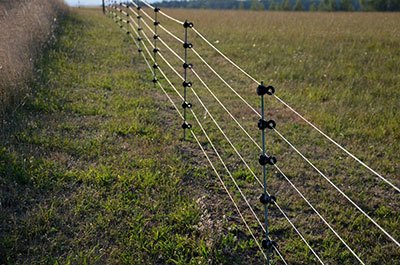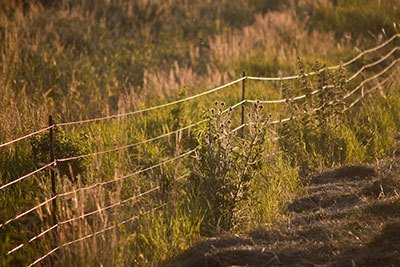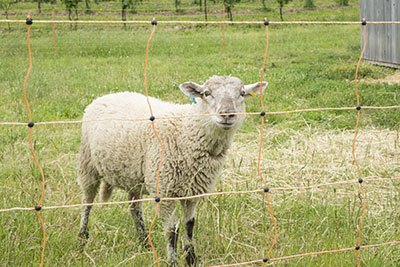Are you looking to make a switch to rotational grazing but find yourself feeling overwhelmed by the choices in electric fencing available?
Then this guide is here to help you. We’ll provide an overview of all aspects of rotational grazing systems and their relevant electrical farm fences so that you can be sure your animals are well-supported as you transition into 2023 and beyond.
You’ll learn about which types of fencing will suit your management needs and the proper use of basic electric fence grazing practises.
Take away key points:
- Electric fencing is a cost-effective, flexible, and safe alternative to traditional fencing methods.
- Rotational grazing is a land management technique designed to promote healthy grazing practices while maintaining optimal forage height and density.
- One of the biggest benefits of rotational grazing system is that you don’t have to keep the entire pasture charged at any time! This will ensure prime grazing time while your pasture maintains itself with minimal observance.
Table of Contents
- Understanding the basics of electric fencing for rotational grazing systems
- Choosing the best electric fence for rotational grazing program needs
- The benefits of electric fencing for grazing rotation
- How to implement electric fencing in your grazing rotation plan
- Key tips and tricks for electric fencing in grazing management
- FAQs
- Final words
Understanding the basics of electric fencing for rotational grazing systems

Electric fencing has become an increasingly popular tool for implementing rotational grazing systems, as it allows farmers to easily and effectively manage their livestock.
So, how does electric fencing really work?
Electric fences use a low-voltage electrical pulse to keep animals contained within a designated area. When an animal touches the fence, it completes an electrical circuit and receives a shock. This shock is typically harmless, but it teaches the animal to avoid the fence and stay within the designated grazing area.
On the other hand, rotational grazing is a technique where farmers can split their entire pasture into several paddocks, allowing animals access to fresh grass, and optimal nutrient intake, thereby promoting healthy growth.
The rest period between grazing cycles allows for regrowth and reattachment of root systems and high-quality feed, which improves soil health and prevents soil compaction while still providing adequate grazing opportunities. and pasture growth.
Choosing the best electric fence for rotational grazing program needs
1. Fence type
There are various types of electric fencing that farmers can choose from, including poly wire, poly tape (both of which refer to materials that consist of fine metal filaments braided with either polyethylene or polypropylene fibers), and electric netting.
2. Fence strength
The voltage of the electric fence energizers and the quantity of ground rods used determine the strength of a portable electric fence. The more ground rods used, the stronger the fence will be. Most electric fence problems come from a poorly grounded system.
You can also select battery operated energizers, but you will have to worry about battery maintenance in order to keep the rotation properly conducted.
3. Fence durability
Electric fences need to be durable enough to withstand the elements and any wear and tear caused by animal activity. Farmers should consider the materials used in building the electric fence charging systems and select a fence that will withstand damage from wind, snow, and animal interaction.
The benefits of electric fencing for grazing rotation

– Cost-effective: Electric fencing is a cost-effective alternative to traditional fencing methods. Electric fences require less material and labor for installation, while the temporary electric fencing for high stock density grazing are easy to move and adjust as needed.
– Flexibility: Electric fencing is highly flexible and allows farmers to create and adjust their grazing areas easily. If a grazing area needs to be reconfigured, the electric fence can be adjusted quickly to accommodate it. Plus, you can choose between pertinent fencing and a temporary electric fencing rotational grazing system.
– Controlled grazing: Electric fences enable farmers to control grazing and confine their animals to specific areas, preventing overgrazing and soil depletion. By keeping animals in smaller areas, farmers can also observe and monitor their animals’ behavior and health more closely with mobile electric fencing. Therefore, you can get a highly movable temporary fence so you can create effective rotational practices while providing adequate feed.
– Improved pasture quality: Rotational grazing with electric fences promotes the regeneration of grass and other plants, which helps improve the overall quality of the pasture.
– Increased operational efficiency: Portable electric fencing for rotational grazing system allows for increased operational efficiency as farmers expend less time moving and controlling their animals.
Reduced labor costs provide returns on investment for farmers. If you plan to opt for temporary fencing, make sure you use electric fence reels. Reels are made from weather-resistant plastic, so they can hold up pretty well.
Additionally, the rotational program will help you take advantage of the drier, more prolific growth in your farm. While some portions offer more use, others will regrow and offer a constant supply of food.
How to implement electric fencing in your grazing rotation plan
Step #1: Identify the grazing area
The primary step involves identifying the grazing area; the area can be divided into paddocks of different sizes, and shapes, or in a way that best suits the grazing rotation plan.
Step #2: Choose appropriate fencing material
Select a recommended fencing material that can cater for the specific needs of the grazing animals. For instance, sturdy fencing material should be used for large farm animals, while soft, flexible fencing material suited to smaller livestock may be used.
Step #3: Install the fence posts
The fencing posts should be of the appropriate length and wire spacings needed to hold the specific fence material.
The posts should be anchored to the ground to ensure stability to prevent the fence from being uprooted by animals if shaken or leaned.
Step #4: Attach insulators
After installing the fence post, an insulated cable should be attached to each post to protect and insulate the electric charge from the fence.
Insulators are crucial in ensuring that the electric fence does not come into contact with the soil or weeds. Make sure you always have an adequate power supply so you don’t encounter electric fence problems.
Step #5: Run the fencing wire
Run the electric fencing wire along the fence posts, and test it to ensure that the appropriate electric charge flows through the wire. When running the wire, leave enough slack in the wire to allow for animal movement and stretch.
Step #6: Connect the fence energizer
Connect the fence energizers to the fence wire and the ground rods. The ground rods should be located in a wet area to ensure good conductivity of the electric charge. The energizer sends an electrical pulse into the wire and fence post, creating an electric charge. The best fence energizers will deliver you power up to 8,000 volts.
Key tips and tricks for electric fencing in grazing management

1. Use the right energizer
The energizer is a crucial component in the electric fencing system. Always purchase the right energizer that is appropriate for the fence’s length and the number of animals it will contain.
2. Properly ground the system
Grounding system is the key to the effectiveness of an electric fence. When you locate ground rods, they should be well-connected, and the electrical circuit should always be kept clean and dry in the grounding system.
3. Regularly check for damage
Regularly inspect the electric fence for damage or loose connections. The fence wire should be tightened, and any broken posts should be replaced promptly. You can always test the quality with the KV fence voltage meter.
4. Use a high-quality wire
Invest in high-quality fencing fine wires that are durable and robust enough to withstand harsh environmental conditions. To electrify about half a mile of poly wire, set up the energizer in the middle of the fence and extend half a mile in each direction. When dividing large pastures, use a single high-tensile wire along the edge, and run the temporary wire from this feeder wire.
5. Install adequate warning signs
Adequate warning signs should be placed at regular intervals along the fence to alert people about the presence of the electric fence. This helps prevent accidents caused by accidental contact with the fence and poor animal control.
FAQs
What fencing for rotational grazing goats?
Effective fencing options for rotational grazing of goats include woven wire fencing, electric net fencing, high-tensile electric fencing, and electric polywire fencing. Additionally, fiberglass rods are excellent option if you want a to move your fence.
How strong does an electric fence need to be for cattle?
Generally, a fence with an output of 2000–3000 volts is suitable for smaller breeds and grazing areas, while larger breeds require 4000–6000 volts. It’s important to ensure the fence’s voltage level is strong enough to contain the cattle without causing harm.
How many joules should an electric fence have for cattle?

For an electric fence for cattle, the number of joules needed depends on factors such as grazing area size, fence line length, and a number of permanent or temporary electric fence wires. However, as a general rule, 0.5–3 joules are usually sufficient, with smaller areas requiring fewer joules and larger areas requiring more.
Do cows respect electric fences?
Cows can respect electric fences if they are properly trained, the fence is strong enough, physical barriers are in place if necessary, and the cows’ temperament is compatible with electric fencing.
Final words
In conclusion, electric fencing has revolutionized the grazing management of livestock.
It is cost-effective, flexible, promotes healthy grazing practices, and optimizes pasture productivity.
By implementing the key tips and tricks mentioned above, farmers can ensure that their grazing rotation plan works efficiently and effectively, providing a productive and healthy environment for their livestock.
